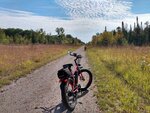I bought an electric mountain bike. I use it primarily for errands and pleasure riding. I thought it offered the most comfort for a novice rider as well as the most versatility, allowing me to trail ride, gravel ride or stick to city streets. Now I'm wondering if I made a mistake by buying a type of e-bike that gets poor range?
I first noticed how I was at a significant disadvantage with rolling resistance when I passed a pack of analog roadies while going uphill, but then, they passed me coasting down that hill.
I'm wondering if electric road bikes, with all other things being equal, get a significantly greater range over mountain ebikes or city/urban ebikes?
With the highest level of assist on my BH ATOM X with a Brose S and 700w battery, I get a disappointing 25-30 mile range. How much better would I do with a road bike with the same battery/motor? If I switched to slicks instead of knobbies, would that eliminate the difference?
I first noticed how I was at a significant disadvantage with rolling resistance when I passed a pack of analog roadies while going uphill, but then, they passed me coasting down that hill.
I'm wondering if electric road bikes, with all other things being equal, get a significantly greater range over mountain ebikes or city/urban ebikes?
With the highest level of assist on my BH ATOM X with a Brose S and 700w battery, I get a disappointing 25-30 mile range. How much better would I do with a road bike with the same battery/motor? If I switched to slicks instead of knobbies, would that eliminate the difference?
